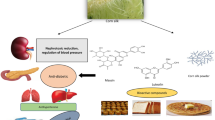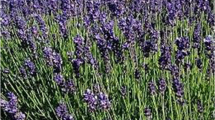Abstract
Aromatic plants have been used worldwide in human diet to improve the flavor and taste of meals or as herbal infusions. Beyond the culinary purposes, these plants are also used for their medicinal purposes, as antimicrobial, anti-inflammatory, antimutagenic and anti-carcinogenic, among others. In the present study, 39 species of condiments and/or herbal infusions were assessed in order to provide scientific information concerning their nutritional value and energetic contribution; furthermore, the fatty acids composition was also evaluated. Carbohydrates were the most abundant compounds in the condiments that also revealed a varied range of sugars with fructose, glucose, sucrose and trehalose detected in all the condiments. In respect to fatty acids, PUFA were prevalent with the great contribution of linoleic and α-linolenic acids among the different 32 detected fatty acids. The herbal infusions revealed low quantities of sugars with most of the plants revealing fructose, glucose and sucrose. In a general way, the energetic value of the condiments and herbal infusions was very low and these plants revealed good nutritional properties that make them suitable for a balanced and diversified low caloric diet. The results obtained in the present systematization study will allow the readers to perform easy and quick comparisons among these different aromatic plants regarding nutritional purposes.

Similar content being viewed by others
References
Suhaj M (2006) Spice antioxidants isolation and their antiradical activity: a review. J Food Compos Anal 19:531–537
Salgueiro L, Martins AP, Correia H (2010) Raw materials: the importance of quality and safety. A review. Flavour Fragr J 25:253–271
Horžić D, Komes D, Belščak A, Ganić KK, Iveković D, Karlovic D (2009) The composition of polyphenols and methylxanthines in teas and herbal infusions. Food Chem 115:441–448
Koedam A (1986) Volatile oil composition of Greek mountain tea (Sideritis spp.). J Sci Food Agric 36:681–684
Yeşilada E, Ezer N (1989) The antiinflammatory activity of some Sideritis species growing in Turkey. J Crude Drug Res 27:38–40
Kaefer CM, Milner JA (2008) The role of herbs and spices prevention. J Nutr Biochem 19:347–361
Mueller M, Hobiger S, Jungbauer A (2010) Anti-inflammatory activity of extracts from fruits, herbs and spices. Food Chem 122:987–996
Tajkarimi MM, Ibrahim SA, Cliver DO (2010) Antimicrobial herb and spice compounds in food. Food Control 21:1199–1218
Nicoli MC, Anese M, Parpinel M (1999) Influence of processing on the antioxidant properties of fruit and vegetables. Trends Food Sci Technol 10:94–100
Gonçalves S, Gomes D, Costa P, Romano A (2013) The phenolic content and antioxidant activity of infusions from Mediterranean medicinal plants. Ind Crop Prod 43:465–471
Ranhotra GSJA, Leinen SD, Vinas MA, Lorenz KJ (1998) Nutritional profile of some edible plants from Mexico. J Food Compos Anal 11:298–304
Kuhnlein HV (1990) Nutrient values in indigenous wild green plants and roots used by the Nuxalk people of Bella Coola, British Columbia. J Food Compos Anal 3:3138–3146
Tolonen M (1990) Vitamins and minerals in health and nutrition. Ellis horwood limited
Toledo A, Burlingame B (2006) Biodiversity and nutrition: a common path toward global food security and sustainable development. J Food Compos Anal 19:477–483
Frison EA, Cherfas J, Hodgkin T (2011) Agricultural biodiversity is essential for a sustainable improvement in food and nutrition security. Sustainability 3:238–253
Heywood VH (2011) Ethnopharmacology, food production, nutrition and biodiversity conservation: towards a sustainable future for indigenous peoples. J Ethnopharmacol 137:1–15
Barros L, Carvalho AM, Ferreira ICFR (2010) The nutritional composition of fennel (Foeniculum vulgare): shoots, leaves, stems and inflorescences. LWT-Food Sci Technol 43:814–818
Dias MI, Barros L, Dueñas M, Alves RC, Oliveira MBPP, Santos-Buelga C, Ferreira ICFR (2014) Nutritional and antioxidant contributions of Laurus nobilis L. leaves: would be more suitable a wild or a cultivated sample? Food Chem 156:339–346
Patel S (2014) Hibiscus sabdariffa: an ideal yet-exploited candidate for nutraceutical applications. Biomed Prev Nutr 4:23–27
AOAC (1995) Official Methods of Analysis, 16th edn. Arlington, USA: Association of Official Analytical Chemists
Barros L, Pereira E, Calhelha RC, Dueñas M, Carvalho AM, Santos-Buelga C, Ferreira ICFR (2013) Bioactivity and chemical characterization in hydrophilic and lipophilic compounds of Chenopodium ambrosioides L. J Funct Foods 5:1732–1740
Sharon N (1980) Carbohydrates. Sci Am 243:90–116
Ghazarian H, Idoni B, Oppenheimer SB (2011) A glycobiology review: carbohydrates, lectins and implications in cancer therapeutics. Acta Histochem 113:236–247
Simopoulos AP (2011) Evolutionary aspects of diet: the omega-6/omega-3 ratio and the brain. Mol Neurobiol 44:203–215
Conflict of Interest
The authors declare they have no conflict of interest.
Author information
Authors and Affiliations
Corresponding author
Electronic supplementary material
Below is the link to the electronic supplementary material.
ESM 1
(PDF 356 kb)
Rights and permissions
About this article
Cite this article
Pereira, C., Barros, L. & Ferreira, I.C.F.R. A Comparison of the Nutritional Contribution of Thirty-nine Aromatic Plants used as Condiments and/or Herbal Infusions. Plant Foods Hum Nutr 70, 176–183 (2015). https://doi.org/10.1007/s11130-015-0476-7
Published:
Issue Date:
DOI: https://doi.org/10.1007/s11130-015-0476-7




